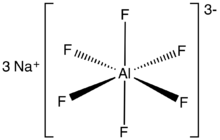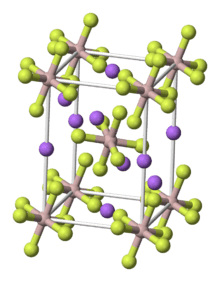Sodium hexafluoroaluminate
Sodium aluminium hexafluoride is an inorganic compound with formula Na3AlF6. This white solid, discovered by José Bonifácio de Andrada e Silva, occurs naturally as the mineral cryolite and is used extensively in the industrial production of aluminium metal. The compound is the sodium (Na+) salt of the hexafluoroaluminate (AlF63−) ion.
 | |
 | |
| Names | |
|---|---|
| Other names
Sodium fluoroaluminate Cryolite Kryolite Aluminate(3-), hexafluoro-, trisodium, (OC-6-11)- | |
| Identifiers | |
3D model (JSmol) |
|
| ChEBI | |
| ChemSpider | |
PubChem CID |
|
CompTox Dashboard (EPA) |
|
| |
| |
| Properties | |
| Na3AlF6 | |
| Molar mass | 209.94 g/mol |
| Appearance | white powder |
| Density | 2.9 g/cm3, solid |
| Melting point | 950 °C (1,740 °F; 1,220 K) |
| Boiling point | decomposes |
| 0.04% (20°C)[1] | |
| Vapor pressure | essentially 0 |
| Hazards | |
EU classification (DSD) (outdated) |
not listed |
| Lethal dose or concentration (LD, LC): | |
LDLo (lowest published) |
900 mg/kg (rabbit, oral)[2] |
| NIOSH (US health exposure limits): | |
PEL (Permissible) |
TWA 2.5 mg/m3[1] |
REL (Recommended) |
TWA 2.5 mg/m3[1] |
IDLH (Immediate danger) |
250 mg/m3 (as F)[1] |
Except where otherwise noted, data are given for materials in their standard state (at 25 °C [77 °F], 100 kPa). | |
| Infobox references | |
Production
Most cryolite is manufactured from aluminium oxides, hydrofluoric acid, and sodium hydroxide or the equivalent reagent hexafluorosilicic acid:[3]
- 6 NaOH + Al2O3 + 12 HF → 2 Na3AlF6 + 9 H2O
The mineral cryolite was mined at Ivigtût on the west coast of Greenland until the deposit was depleted in 1987.
Use
The main application of synthetic cryolite is as a solvent (or flux) for electrolysis of aluminium oxides such as bauxite. The conversion of aluminium oxides into metallic aluminium requires that the metal ions be dissolved so that they can accept the electrons provided in the electrolysis cell. A mixture of cryolite and some aluminium trifluoride is used as that solvent. Unlike typical solutions, this one requires temperatures approaching 1000 °C to melt. Sodium aluminium hexafluoride is also used as a pesticide. Other uses include a whitener for enamels and an opacifier for glass.[4]
Solubility
Cryolite is poorly soluble in water. The LD50 is 600 mg/kg for the comparable compound aluminium trifluoride.[3]
References
- NIOSH Pocket Guide to Chemical Hazards. "#0559". National Institute for Occupational Safety and Health (NIOSH).
- "Fluorides (as F)". Immediately Dangerous to Life and Health Concentrations (IDLH). National Institute for Occupational Safety and Health (NIOSH).
- J. Aigueperse, P. Mollard, D. Devilliers, M. Chemla, R. Faron, R. Romano, J. P. Cuer, "Fluorine Compounds, Inorganic" in Ullmann’s Encyclopedia of Industrial Chemistry, Wiley-VCH, Weinheim, 2005.doi:10.1002/14356007.a11_307
- http://www.mineralszone.com/minerals/cryolite.html